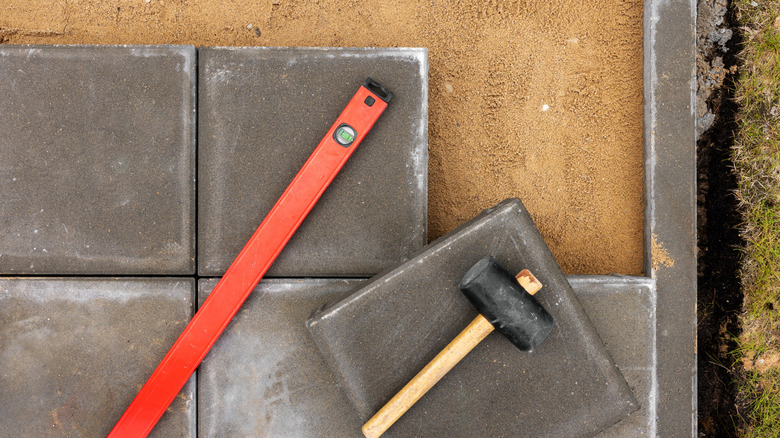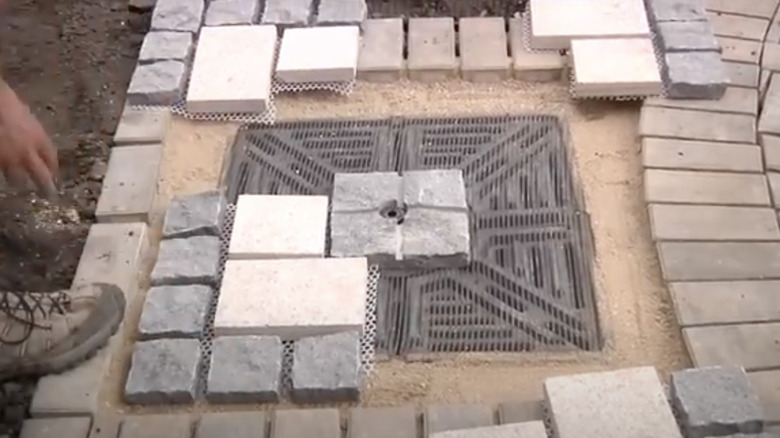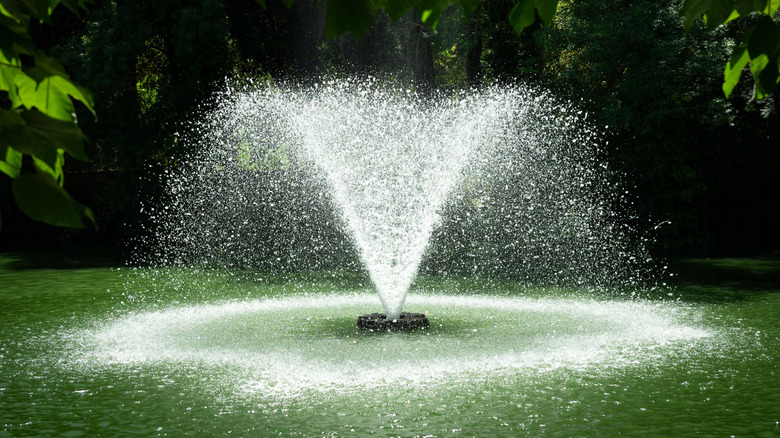How To Use Pavers To Make A Fun Patio Fountain
We may receive a commission on purchases made from links.
Pavers are an attractive and versatile option for patios, paths, and driveways. Fountains can be used to add privacy and drown out noise or to provide an interesting focal point. Pair the two together, and you get your next dream project. Typically, patio fountains employ some kind of container or statuary, which can look great but can also be cumbersome in a small space. In this article, we're going to create a fun patio fountain that could be anything from a low cascade to a tall spray, but when it's turned off, most people won't even notice it's there.
The easiest way to DIY this project is to use a solar-powered fountain pump. Having choices is important because the power of the pump and associated panel will have a major impact on the display. For example, the 6-watt Popsoap Solar Bird Bath Fountain Pump has a maximum lift of 32 inches, whereas the 20-watt model has a lift of up to 7.5 feet. Although the pump itself will be hidden, you'll want to take into account the physical size of the solar panel and how far from the fountain it can be positioned.
For this project, we'll be talking about a fresh installation. If you already have a patio, it may be possible to retro-fit a solar-powered fountain pump, but you will need to lift existing slabs or pavers. More experienced DIYers might also want to consider a traditionally wired fountain pump, and we have some suggestions for that too.
Installing a hidden paver patio fountain
In the planning stage, you'll want to think about where to position your patio fountain. The secret to hiding it is the reservoir used, which sits below ground level with the pavers running over the top to conceal it. One example of a reservoir that would work for this project is the EasyPro Pond Products Redi-Basin. A key feature is that it is reinforced to support up to 300 pounds, so it's okay to walk across. Choosing the right kind of pavers is the next important, and arguably more fun, decision to make.
Constructing your patio goes beyond the scope of this article. But the process usually involves removing sod, laying gravel for drainage along with a barrier of landscape fabric, more gravel or sand, and finally the pavers. There are many useful videos online to help with this. Pavers are usually set in sand rather than mortar, so planning where to put them comes with less pressure.
Installing the reservoir is simply a matter of digging a hole of the appropriate size and depth so that when the pavers are placed on top, the upper surface of the patio is level. When using a solar-powered fountain pump, the only connection required is the cable to the solar panel. The pump just pops into the reservoir, which is filled by using a bucket or watering can before the pavers are laid over the top. One or two pavers may need to be modified to allow the water to jet out. You can use a hammer and chisel or an angle grinder to do this.
Upgrading your patio fountain to fit your needs
A solar-powered fountain pump is a great choice for a beginner DIY project, and most come with a variety of spray patterns. With no need for mains wiring or water connections, your fun paver fountain could also be an interesting way to repurpose old pavers in other parts of your yard or garden where hookups would typically be awkward. However, the solar panel does need to be placed where it receives the maximum amount of sunlight possible, so performance will drop considerably on overcast days.
The alternative is to use a submersible fountain pump that is hard-wired to the household supply. This also has the advantage that it could be combined with lighting and used at night when a solar fountain won't function at all. Cabling should pass through some kind of trunking to protect it, and for aesthetics, would probably be best to run underground. It also needs to be connected to a ground fault circuit interrupter (GFCI), which is recommended for electrical connections near water. Those without the relevant knowledge should call in a qualified electrical contractor.
Using the same kind of reservoir as described above would mean you wouldn't need to provide water from a main pipeline. However, much depends on the demands of the pump, and a separate water source, which would also need to be buried, might also be demanded. If it's a retrofit to an existing patio, lifting existing pavers would add further complication, though it should be possible to use a flat screwdriver blade or pry bar.


